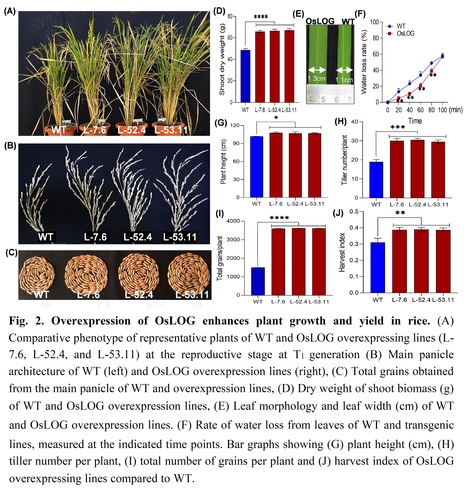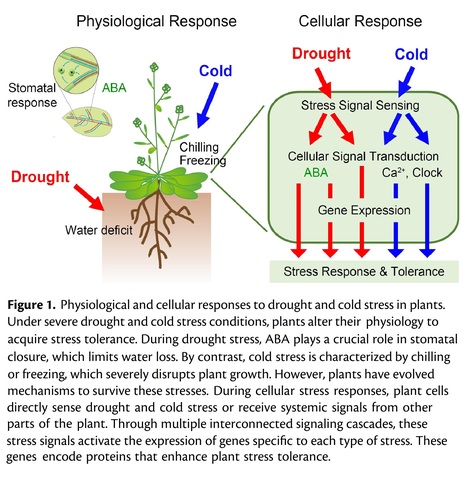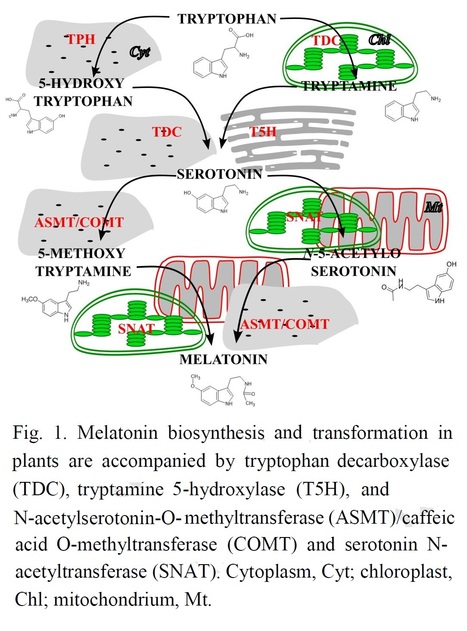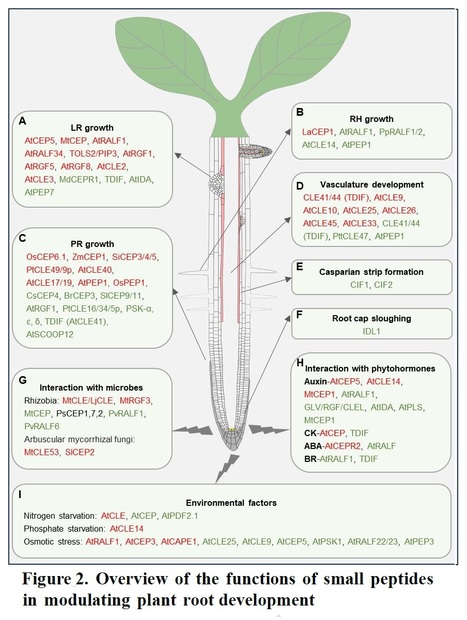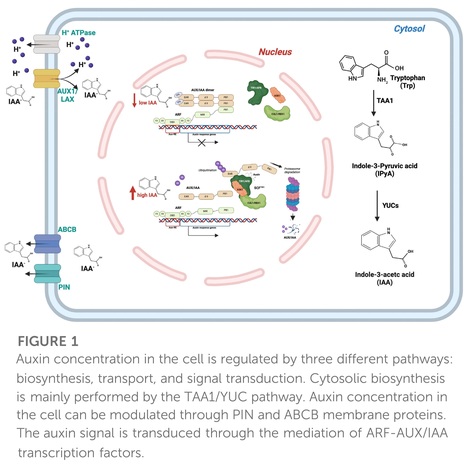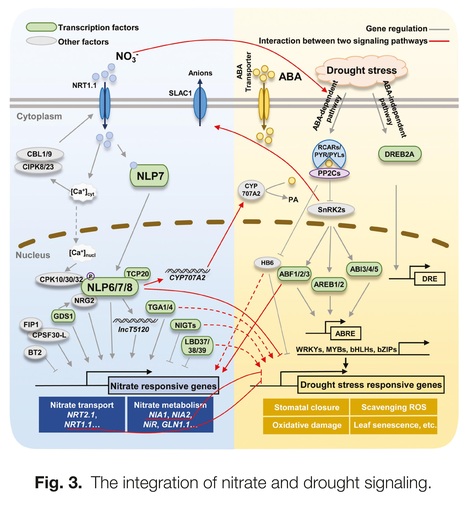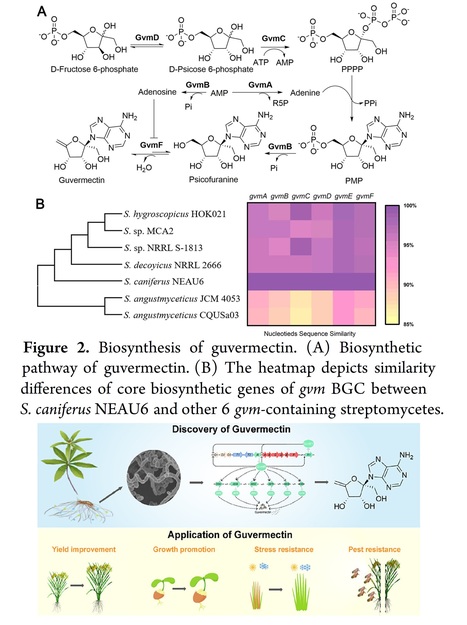 Your new post is loading...
 Your new post is loading...
Authors: J. S. Chen, S. T. Wang, Q. Mei, T. Sun, J. T. Hu, G. S. Xiao, H. Chen and Y. H. Xuan.
Plant Molecular Biology (2024)
Abstract: "Plants have a variety of regulatory mechanisms to perceive, transduce, and respond to biotic and abiotic stress. One such mechanism is the calcium-sensing CBL–CIPK system responsible for the sensing of specific stressors, such as drought or pathogens. CBLs perceive and bind Calcium (Ca2+) in response to stress and then interact with CIPKs to form an activated complex. This leads to the phosphorylation of downstream targets, including transporters and ion channels, and modulates transcription factor levels and the consequent levels of stress-associated genes. This review describes the mechanisms underlying the response of the CBL–CIPK pathway to biotic and abiotic stresses, including regulating ion transport channels, coordinating plant hormone signal transduction, and pathways related to ROS signaling. Investigation of the function of the CBL–CIPK pathway is important for understanding plant stress tolerance and provides a promising avenue for molecular breeding."
Authors: Faisal Zulfiqar, Anam Moosa, Hayssam M. Ali, Núria F. Bermejo and Sergi Munné-Bosch.
Plant Physiology and Biochemistry (2024)
Highlights: • Biostimulants are biobased solutions to tackle modern agriculture problems • For tackling climate change issue, biostimulants are not enough • Stopping wars and conflicts is the main solution to save environment and agriculture
Abstract: "Climate change is currently one of the main concerns of the agricultural sector, as it limits crop production and quality. Furthermore, the current context of global crisis with international political instability and war conflicts over the world is pushing the agricultural sector even more to urgently boost productivity and yield and doing so in a sustainable way in the current frame of climate change. Biostimulants can be an effective tool in alleviating the negative effects of environmental stresses to which plants are exposed, such as drought, salinity, heavy metals and extreme temperatures. Biostimulants act through multiple mechanisms, modifying gene expression, metabolism and phytohormone production, promoting the accumulation of compatible solutes and antioxidants and mitigating oxidative stress. However, it is important to keep in mind that the use and effect of biostimulants has limitations and must be accompanied by other techniques to ensure crop yield and quality in the current frame of climate change, such as proper crop management and the use of other sustainable resources. Here, we will not only highlight the potential use of biostimulants to face future agricultural challenges, but also take a critical look at their limitations, underlining the importance of a broad vision of sustainable agriculture in the current context of climate change."
Authors: Akbar Ali, Krishan Kant, Navneet Kaur, Shalu Gupta, Parnika Jindal, Sarvajeet Singh Gill and M. Naeem.
South African Journal of Botany (2024)
Highlights: • Salicylic acid (SA) has encouraging effects on the growth and development of plants. • SA stimulates signalling in plants via several stress proteins and genes. • SA positively interacts with other phytohormones. • SA enhances plant tolerance towards abiotic stress.
Abstract: "Drastic change in global climatic conditions has significantly increased the frequency of abiotic stresses, such as different temperature regimes (high, low, or freezing stress), uneven precipitation leading to flooding or drought, soil salinization, cyclones and hurricanes which pose a major challenge to the crop productivity and food security. Therefore, it becomes imperative for the global science community to engineer stress tolerance in crop plants to ensure enough food for the globe. Plant growth regulators play an important function in stress management. One putative plant hormone that aids plants in coping with biotic and abiotic stressors is salicylic acid (SA). SA also cooperates with other phytohormones, such as gibberellins, auxins, abscisic acid, jasmonic acid, ethylene, polyamines, nitric oxide, and to counter the negative effects of environmental perturbations. Moreover, SA shields plants from oxidative stress by reducing the production of reactive oxygen species in challenging circumstances. Additionally, SA stimulates gas exchange, photosynthesis, and osmolyte synthesis in plants, which counteract the damage caused by ROS. Exogenous application of SA to agricultural crops including medicinal and aromatic plants improves their abiotic stress tolerance, either individually or in combination with other phytohormones. SA can stimulate the production of secondary metabolites by controlling the expression of stress-related genes, activating or regulating several key enzymes, and balancing the ion content. The present review summarizes the various mechanisms by which SA confers abiotic stress tolerance in plants through homeostasis, signalling, and crosstalk with other phytohormones."
Authors: Adrián González Ortega-Villaizán, Eoghan King, Manish K. Patel and Stephan Pollmann.
In: Progress in Botany (2024)
Abstract: "Plants are constantly challenged by a wide range of adverse conditions in their ever-changing environment. Abiotic stresses, including drought, heat, cold, and salinity, are among the main stress cues that negatively affect plant growth, development, and productivity. To survive, plants use a sophisticated network of phytohormones to integrate signals from their environment and adapt their developmental processes according to the prevailing conditions. Plant hormones are pivotal as they drive secondary plant biological processes, controlling not only adequate stress responses, but also adjust plant growth, development, and metabolism. The different plant hormones can interact additively, synergistically, or antagonistically. These interactions create a delicate and dynamic regulatory framework whose net output is largely dependent on the combined action of the participating plant hormones rather than on the isolated activities of the individual phytohormones. In this work, we discuss the crosstalk of abscisic acid (ABA) with some of the major plant hormones in controlling plant responses to abiotic stress conditions."
Authors: Minmin He, Gui Geng, Shuyang Mei, Gang Wang, Lihua Yu, Yao Xu and Yuguang Wang.
Functional Plant Biology (2024)
Abstract: "Water stress (drought and waterlogging) leads to an imbalance in plant water distribution, disrupts cell homeostasis, and severely inhibits plant growth. Melatonin is a growth hormone that plants synthesise and has been shown to resist adversity in many plants. This review discusses the biosynthesis and metabolism of melatonin, as well as the changes in plant morphology and physiological mechanisms caused by the molecular defence process. Melatonin induces the expression of related genes in the process of plant photosynthesis under stress and protects the structural integrity of chloroplasts. Exogenous melatonin can maintain the dynamic balance of root ion exchange under waterlogging stress. Melatonin can repair mitochondria and alleviate damage caused by reactive oxygen species and reactive nitrogen species; and has a wide range of uses in the regulation of stress-specific genes and the activation of antioxidant enzyme genes. Melatonin improves the stability of membrane lipids in plant cells and maintains osmotic balance by regulating water channels. There is crosstalk between melatonin and other hormones, which jointly improve the ability of the root system to absorb water and breathe and promote plant growth. Briefly, as a multifunctional molecule, melatonin improves the tolerance of plants under water stress and promotes plant growth and development."
Authors: Ray Singh Rathore, Manjari Mishra, Ashwani Pareek and Sneh Lata Singla-Pareek.
Plant Physiology and Biochemistry (2024)
Highlights: • Overexpression of Lonely Guy (OsLOG) gene in rice leads to increase in the active form (trans-zeatin) of cytokinin. • OsLOG mediated elevated cytokinin levels promote ideal plant architecture and rice yield. • Elevated cytokinin levels in OsLOG transgenic lines enhance tolerance to drought and salinity stress and reduce yield penalty through maintenance of redox homeostasis.
Abstract: "Meristem activity is important for normal plant growth as well as adaptive plastic development under abiotic stresses. Cytokinin has been recognized to have a major role in regulating meristem function which is controlled by cytokinin activating enzymes by fine-tuning the concentrations and spatial distribution of its bioactive forms. It was previously reported that LONELY GUY (LOG) acts in the direct activation pathway of cytokinin in rice shoot meristems. LOG has a cytokinin specific phosphoribohydrolase activity, which transforms inactive cytokinin nucleotides into active free bases. Here, we explored the role of OsLOG in controlling meristem activity mediated by cytokinin and its effects on growth, development, and stress resilience of rice plants. Overexpression of OsLOG in rice led to significant alterations in cytokinin levels in the inflorescence meristem, leading to enhanced plant growth, biomass and grain yield under both non-stress as well as stress conditions such as drought and salinity. Moreover, our study provides insight into how overexpression of OsLOG improves the ability of plants to withstand stress. The OsLOG-overexpressing lines exhibit reduced accumulation of H2O2 along with elevated antioxidant enzyme activities, thereby maintaining better redox homeostasis under stress conditions. This ultimately reduces the negative impact of stresses on grain yield and improves harvest index, as evidenced by observations in the OsLOG-overexpressing lines. In summary, our study emphasizes the diverse role of OsLOG, not only in regulating plant growth and yield via cytokinin but also in enhancing adaptability to abiotic stresses. This highlights its potential to improve crop yield and promote sustainable agriculture."
Authors: Lining Liu, Xing Liu, Zhenkun Bai, Mohsin Tanveer, Yujing Zhang, Wenjie Chen, Sergey Shabala and Liping Huang.
Plant Science (2024)
Highlights: • Rapid alkalinization factor (RALF) peptides modulate pH of the extracellular matrix in plant cells. • RALFs play key role in plant growth and development. • RALFs are important regulators in plant intercellular communications, integrating various environmental cues. • Important role of RALFs as component of abiotic stress tolerance mechanisms has emerged.
Abstract: "Plants live in a highly dynamic environment and require to rapidly respond to a plethora of environmental stimuli, so that to maintain their optimal growth and development. A small plant peptide, rapid alkalization factor (RALF), can rapidly increase the pH value of the extracellular matrix in plant cells. RALFs always function with its corresponding receptors. Mechanistically, effective amount of RALF is induced and released at the critical period of plant growth and development or under different external environmental factors. Recent studies also highlighted the role of RALF peptides as important regulators in plant intercellular communications, as well as their operation in signal perception and as ligands for different receptor kinases on the surface of the plasma membrane, to integrate various environmental cues. In this context, understanding the fine-print of above processes may be essential to solve the problems of crop adaptation to various harsh environments under current climate trends scenarios, by genetic means. This paper summarizes the current knowledge about the structure and diversity of RALF peptides and their roles in plant development and response to stresses, highlighting unanswered questions and problems to be solved."
Authors: June-Sik Kim, Satoshi Kidokoro, Kazuko Yamaguchi-Shinozaki and Kazuo Shinozaki.
Plant Physiology (2024)
Abstract: "Drought and cold represent distinct types of abiotic stress, each initiating unique primary signaling pathways in response to dehydration and temperature changes, respectively. However, a convergence at the gene regulatory level is observed where a common set of stress-responsive genes is activated to mitigate the impacts of both stresses. In this review, we explore these intricate regulatory networks, illustrating how plants coordinate distinct stress signals into a collective transcriptional strategy. We delve into the molecular mechanisms of stress perception, stress signaling, and the activation of gene regulatory pathways, with a focus on insights gained from model species. By elucidating both the shared and distinct aspects of plant responses to drought and cold, we provide insight into the adaptive strategies of plants, paving the way for the engineering of stress-resilient crop varieties that can withstand a changing climate."
Authors: Chunyu Shang, Xiaoyan Liu, Guo Chen, Guobin Li, Songshen Hu, Hao Zheng, Lei Ge, Yanghao Long, Qiaomei Wang and Xiaohui Hu.
The Plant Journal (2024)
Significance Statement: In brief, in the presence of saline-alkali stress, the concentration of tomato JA is increased, acting as a signaling molecule to induce the expression of SlWRKY81 while repressing the expression of SlJAZ1. At the protein level, SlJAZ1 interacts with SlWRKY81, and the suppression of SlJAZ1 expression results in the release of additional SlWRKY81. Simultaneously, SlWRKY81 actively regulates the downstream genes SlSPDS2 and SlNHX4, promoting the synthesis of Spd and the maintenance of Na+/K+ homeostasis, thereby displaying a favorable response to saline-alkali stress. Saline-alkali stress increased JA content in tomato, which promoted the expression of SlWRKY80 and increased the regulation of downstream SlSPDS2 and SlNHX4. On the one hand, an increase in JA content inhibits the expression of SlJAZ1 (the interaction between SlJAZ1 protein and SlWRKY80 protein), releases more SlWRKY80 protein, strengthens the regulation of downstream SlSPDS2 and SlNHX4, synthesizes Spd and promotes ion balance, thereby positively regulating saline-alkali stress.
Abstract: "Saline-alkali stress is an important abiotic stress factor affecting tomato (Solanum lycopersicum L.) plant growth. Although the involvement of the tomato SlWRKY gene family in responses to saline-alkali stress has been well established, the mechanism underlying resistance to saline-alkali stress remains unclear. In this study, we investigated the role of SlWRKY81 in conferring saline-alkali stress resistance by using overexpression and knockout tomato seedlings obtained via genetic modification. We demonstrated that SlWRKY81 improves the ability of tomato to withstand saline-alkali stress by enhancing antioxidant capacity, root activity, and proline content while reducing malondialdehyde levels. Saline-alkali stress induces an increase in jasmonic acid (JA) content in tomato seedlings, and the SlWRKY81 promoter responds to JA signaling, leading to an increase in SlWRKY81 expression. Furthermore, the interaction between SlJAZ1 and SlWRKY81 represses the expression of SlWRKY81. SlWRKY81 binds to W-box motifs in the promoter regions of SlSPDS2 and SlNHX4, thereby positively regulating their expression. This regulation results in increased spermidine (Spd) content and enhanced potassium (K+) absorption and sodium (Na+) efflux, which contribute to the resistance of tomato to saline-alkali stress. However, JA and SlJAZ1 exhibit antagonistic effects. Elevated JA content reduces the inhibitory effect of SlJAZ1 on SlWRKY81, leading to the release of additional SlWRKY81 protein and further augmenting the resistance of tomato to saline-alkali stress. In summary, the modulation of Spd synthesis and Na+/K+ homeostasis mediated by the interaction between SlWRKY81 and SlJAZ1 represents a novel pathway underlying tomato response to saline-alkali stress."
Authors: Romica Verma, Bhavana Sharma and Gulzar A. Rather.
In book: Strigolactones - Synthesis, Application and Role in Plants (2024)
Abstract: "Strigolactones (SLs) are a class of plant hormones that are derived from carotenoids. They play a crucial function in growth and development and provide strong resilience against specific bacterial and fungal pathogens. The biosynthesis of SLs is severe in response to the stresses that plants face during different developmental processes. SLs are primarily synthesized in the roots, and their prime function is to interact with auxin for the regulation of salinity and drought response. Recently, SLs have been given much consideration due to their vital importance in the maintenance of numerous molecular and physiological adjustments of several plant species under biotic stresses. Moreover, evidence of the interaction between SLs with other phytohormones, mainly abscisic acid, against stress proposes that SLs participate actively in regulating stress in plant systems. Therefore, SLs are potential targets for agricultural crops to enhance their biotic and abiotic stress ability. Hence, the SL-based engineering of plants will provide a considerable archetype shift in the field of crop protection and enhancement by replacing the classical approaches of pests/disease management. Inclusively, this chapter will provide insights into SLs synthesis, signaling, and their role in regulation of biotic and abiotic stresses, and highlight some aspects of SLs function in distinct areas of agriculture."
Authors: Dandan Hu, Ruifan Cui, Ke Wang, Yuming Yang, Ruiyang Wang, Hongqing Zhu, Mengshi He, Yukun Fan, Le Wang, Li Wang, Shanshan Chu, Jinyu Zhang, Shanshan Zhang, Yifei Yang, Xuhao Zhai, Haiyan Lv, Dandan Zhang, Jinshe Wang, Fanjiang Kong, Deyue Yu, Hengyou Zhang and Dan Zhang.
The Plant Cell (2024)
One-sentence summary: The major quantitative trait locus gene GmGDPD2 controls root and phosphorus efficiency traits and interacts with Myb73 and GA2ox1 to enhance yield traits.
Abstract: "Phosphorus is indispensable in agricultural production. An increasing food supply requires more efficient use of phosphate due to limited phosphate resources. However, how crops regulate phosphate efficiency remains largely unknown. Here, we identified a major quantitative trait locus, qPE19, that controls seven low-phosphate (LP)-related traits in soybean (Glycine max) through linkage mapping and genome-wide association studies. We identified the gene responsible for qPE19 as GLYCEROPHOSPHORYL DIESTER PHOSPHODIESTERASE2 (GmGDPD2), and haplotype 5 represents the optimal allele favoring LP tolerance. Overexpression of GmGDPD2 significantly affects hormone signaling and improves root architecture, phosphate efficiency and yield-related traits; conversely, CRISPR/Cas9-edited plants show decreases in these traits. GmMyb73 negatively regulates GmGDPD2 by directly binding to its promoter, thus GmMyb73 negatively regulates LP tolerance. GmGDPD2 physically interacts with GA 2-oxidase 1 (GmGA2ox1) in the plasma membrane, and overexpressing GmGA2ox1 enhances LP-associated traits, similar to GmGDPD2 overexpression. Analysis of double mutants for GmGDPD2 and GmGA2ox1 demonstrated that GmGDPD2 regulates LP tolerance likely by influencing auxin and gibberellin dose-associated cell division in root. These results reveal a regulatory module that plays a major role in regulating LP tolerance in soybean and is expected to be utilized to develop phosphate-efficient varieties to enhance soybean production, particularly in phosphate-deficient soils.
Authors: Izabela Kołodziejczyk and Andrzej Kaźmierczak.
Science of the Total Environment (2024)
Highlights: • Melatonin is a plant biostimulator with promising application potential. • Melatonin is a conserved molecule that performs important functions in all organisms. • As a phytobiostimulant, it upregulates plant growth and development and increases plant tolerance to environmental stresses and thus resistance to unfavourable conditions. • Melatonin may allow human-desired cultivations to be maintained in good condition without introducing unnatural compounds into the environment.
Abstract:"MEL (N-acetyl-5-methoxytryptamine) is a well-known natural compound that controls cellular processes in both plants and animals and is primarily found in plants as a neurohormone. Its roles have been described very broadly, from its antioxidant function related to the photoperiod and determination of seasonal rhythms to its role as a signalling molecule, imitating the action of plant hormones (or even being classified as a prohormone). MEL positively affects the yield and survival of plants by increasing their tolerance to unfavourable biotic and abiotic conditions, which makes MEL widely applicable in ecological farming as a stimulant of growth and development. Thus, it is called a phytobiostimulator. In this review, we discuss the genesis of MEL functions, the presence of MEL at the cellular level and its effects on gene expression and plant development, which can ensure the survival of plants under the conditions they encounter. Moreover, we consider the future application possibilities of MEL in agriculture."
Authors: Yuwen Zhang, Xingliang Duan, Yuanming Xie and Wei Xuan.
New Crops (2024)
Abstract: "Plant root systems are critical for absorbing water and nutrients and anchoring plants in the soil, and their development is regulated by phytohormones and complex signaling pathways. Recent studies have identified small peptides as essential players in governing root development, binding to specific receptors on the cell membrane, and triggering signaling processes. In this study, we summarize recent advances in small peptide regulation of root system architecture and tissue organization, as well as the molecular interaction between peptides and canonical hormone signaling. Additionally, we discuss the functions of small peptides in modulating root development responses to environmental forces like nitrogen and phosphate starvation, osmotic stress, and soil microbes through the activation of local and systemic signaling pathways. This review offers a comprehensive overview of peptide signaling during plant root development and prospects for further crop breeding applications."
|
Authors: Davide Marzi, Patrizia Brunetti, Shashank Sagar Saini, Gitanjali Yadav, Giuseppe Diego Puglia and Raffaele Dello Ioio.
Frontiers in Genetics (2024)
Abstract: "Global climate change (GCC) is posing a serious threat to organisms, particularly plants, which are sessile. Drought, salinity, and the accumulation of heavy metals alter soil composition and have detrimental effects on crops and wild plants. The hormone auxin plays a pivotal role in the response to stress conditions through the fine regulation of plant growth. Hence, rapid, tight, and coordinated regulation of its concentration is achieved by auxin modulation at multiple levels. Beyond the structural enzymes involved in auxin biosynthesis, transport, and signal transduction, transcription factors (TFs) can finely and rapidly drive auxin response in specific tissues. Auxin Response Factors (ARFs) such as the ARF4, 7, 8, 19 and many other TF families, such as WRKY and MADS, have been identified to play a role in modulating various auxin-mediated responses in recent times. Here, we review the most relevant and recent literature on TFs associated with the regulation of the biosynthetic, transport, and signalling auxin pathways and miRNA-related feedback loops in response to major abiotic stresses. Knowledge of the specific role of TFs may be of utmost importance in counteracting the effects of GCC on future agriculture and may pave the way for increased plant resilience."
Authors: Puja Ghosh and Aryadeep Roychoudhury.
Journal of Plant Growth Regulation (2024)
Abstract: "Plants are constantly exposed to a wide range of stress situations, such as biotic stressors caused by pathogenic microbes and herbivores, as well as abiotic stress factors like drought, salinity, and severe temperature. Plants have developed an intricate and sophisticated network of molecular signaling in response to various stresses that allow them to recognize and respond to challenging circumstances. Plant peptides have emerged as key participants in orchestrating biotic and abiotic stress responses, as well as taking part in signaling pathways for reactive oxygen species (ROS). ROS play a key role as secondary messengers in stress signaling and include chemicals, including superoxide, hydrogen peroxide, and singlet oxygen. This exhaustive review investigates the multiple functions of plant peptides in ROS signaling and stress responses and clarifies the interaction between plant peptide-mediated stress responses and ROS signaling. We have highlighted several plant peptide classes such as defense peptides, antimicrobial peptides and signaling peptides that contribute to the complex interaction between abiotic and biotic stress response pathways. A thorough overview of the complex regulatory network that permits plants to flourish under demanding environmental conditions is presented by synthesizing recent gains in our knowledge of the functions of plant peptides in stress responses and ROS signaling. We have also highlighted the fact that knowledge of such peptide-mediated signaling may be used for crop improvement that would increase agricultural sustainability and stress tolerance, ultimately boosting food security and environmental resilience on a global scale."
Authors: Yuming Sun and Alisdair R. Fernie.
Trends in Plant Science (2024)
Highlights Plant secondary metabolism plays a paramount role in plant adaptation to global climate change, a comprehensive understanding of the interplay between plant secondary metabolism and climate variations favors crop improvement in a climate-fluctuating world. Climate changes exert diverse effects on plant secondary metabolism, determined by factors such as metabolite type, stress intensity, and plant species. Combinations of two individual climatic factors can result in an amplifying, neutralizing, or one-factor-dominated consequence, but our knowledge of these consequences is limited. Resource allocation and growth-defense trade-off hypothesis partially explain how plants respond to climate changes through secondary metabolism at the ecological level, while hormone signaling, hormones, and transcriptional and post-transcriptional regulation networks are involved with the molecular mechanisms underlying these responses.
Abstract: "Climate changes have unpredictable effects on ecosystems and agriculture. Plants adapt metabolically to overcome these challenges, with plant secondary metabolites (PSMs) being crucial for plant–environment interactions. Thus, understanding how PSMs respond to climate change is vital for future cultivation and breeding strategies. Here, we review PSM responses to climate changes such as elevated carbon dioxide, ozone, nitrogen deposition, heat and drought, as well as a combinations of different factors. These responses are complex, depending on stress dosage and duration, and metabolite classes. We finally identify mechanisms by which climate change affects PSM production ecologically and molecularly. While these observations provide insights into PSM responses to climate changes and the underlying regulatory mechanisms, considerable further research is required for a comprehensive understanding."
Authors: Yiran Xu, Shengdong Qi, Yong Wang and Jingbo Jia.
Journal of Experimental Botany (2024)
One-sentence summary: This review summarizes the interplay between nitrate and abscisic acid and provides research perspectives for breeding high nitrogen use efficiency and stress-tolerant crop varieties.
Abstract: "To meet the demands of the new Green Revolution and sustainable agriculture, it is important to develop crop varieties with improved yield, nitrogen use efficiency, and stress resistance. Nitrate is the major form of inorganic nitrogen available for plant growth in many well-aerated agricultural soils, and acts as a signaling molecule regulating plant development, growth, and stress responses. Abscisic acid (ABA), an important phytohormone, plays vital roles in integrating extrinsic and intrinsic responses and mediating plant growth and development in response to biotic and abiotic stresses. Therefore, elucidating the interplay between nitrate and ABA can contribute to crop breeding and sustainable agriculture. Here, we review studies that have investigated the interplay between nitrate and ABA in root growth modulation, nitrate and ABA transport processes, seed germination regulation, and drought responses. We also focus on nitrate and ABA interplay in several reported omics analyses with some important nodes in the crosstalk between nitrate and ABA. Through these insights, we proposed some research perspectives that could help to develop crop varieties adapted to a changing environment and to improve crop yield with high nitrogen use efficiency and strong stress resistance."
Authors: Muhmmad Asad Ullah Asad, Zhang Yan, Lujian Zhou, Xianyue Guan and Fangmin Cheng.
Plant Physiology and Biochemistry (2024)
Highlights: • Sugars play an essential role in the regulations of leaf senescence. • Abiotic stresses trigger sugar signaling by inducing reactive oxygen species burst. • Sugar signaling interact with plant hormones and protein kinase to regulates leaf senescence. • Abiotic stresses target sugar signaling to regulate photosynthesis inhibition and programmed cell death (PCD).
Abstract: "Plants have evolved the adaptive capacity to mitigate the negative effect of external adversities at chemical, molecular, cellular, and physiological levels. This capacity is conferred by triggering the coordinated action of internal regulatory factors, in which sugars play an essential role in the regulating chloroplast degradation and leaf senescence under various stresses. In this review, we summarize the recent findings on the senescent-associated changes in carbohydrate metabolism and its relation to chlorophyll degradation, oxidative damage, photosynthesis inhibition, programmed cell death (PCD), and sink-source relation as affected by abiotic stresses. The action of sugar signaling in regulating the initiation and progression of leaf senescence under abiotic stresses involves interactions with various plant hormones, reactive oxygen species (ROS) burst, and protein kinases. This discussion aims to elucidate the complex regulatory network and molecular mechanisms that underline sugar-induced leaf senescence in response to various abiotic stresses. The imperative role of sugar signaling in regulating plant stress responses potentially enables the production of crop plants with modified sugar metabolism. This, in turn, may facilitate the engineering of plants with improved stress responses, optimal life span and higher yield achievement."
Authors: Showkat Ahmad Ganie, Nancy McMulkin and Alessandra Devoto.
Plant, Cell & Environment (2024)
Summary statement: The expression of rice core component circadian clock gene LATE ELONGATED HYPOCOTYL can be induced under salt stress, which alters the expression of Na+ and K+ transporter related genes and genes in the ABA signalling pathway to positively regulate salt stress tolerance in rice.
Abstract: "Plant responses to abiotic stresses are dynamic, following the unpredictable changes of physical environmental parameters such as temperature, water and nutrients. Physiological and phenotypical responses to stress are intercalated by periods of recovery. An earlier stress can be remembered as ‘stress memory’ to mount a response within a generation or transgenerationally. The ‘stress priming’ phenomenon allows plants to respond quickly and more robustly to stressors to increase survival, and therefore has significant implications for agriculture. Although evidence for stress memory in various plant species is accumulating, understanding of the mechanisms implicated, especially for crops of agricultural interest, is in its infancy. Rice is a major food crop which is susceptible to abiotic stresses causing constraints on its cultivation and yield globally. Advancing the understanding of the stress response network will thus have a significant impact on rice sustainable production and global food security in the face of climate change. Therefore, this review highlights the effects of priming on rice abiotic stress tolerance and focuses on specific aspects of stress memory, its perpetuation and its regulation at epigenetic, transcriptional, metabolic as well as physiological levels. The open questions and future directions in this exciting research field are also laid out."
Authors: Chongxi Liu, Manman Zhang, Lei Li, Xiangjing Wang, Shanshan Li and Wensheng Xiang.
Journal of Agricultural and Food Chemistry (2024)
Abstract: "Plant growth regulators (PGRs) play an important role in alleviating the detrimental effects of biotic and abiotic stress and improving crop yield and quality. As a novel PGR from Streptomyces registered in 2021, guvermectin (GV) has the potential to improve plant yield and defense, making its application in agriculture a subject of interest. Here, we describe the discovery process, functional activities, agricultural applications, toxicity, environmental safety, and biosynthetic mechanism of GV. This Perspective provides a guide for the development of novel PGRs from microorganisms."
Authors: Ronald J. Myers, María Ángeles Peláez-Vico and Yosef Fichman.
Plant, Cell & Environment (2024)
One-sentence summary: Reactive oxygen species waves can be triggered by varying types of stress stimuli in local tissues and spread from cell to cell to induce systemic acclimation.
Abstract: "Reactive oxygen species (ROS) play a critical role in plant development and stress responses, acting as key components in rapid signalling pathways. The ‘ROS wave’ triggers essential acclimation processes, ultimately ensuring plant survival under diverse challenges. This review explores recent advances in understanding the composition and functionality of the ROS wave within plant cells. During their initiation and propagation, ROS waves interact with other rapid signalling pathways, hormones and various molecular compounds. Recent research sheds light on the intriguing lack of a rigid hierarchy governing these interactions, highlighting a complex interplay between diverse signals. Notably, ROS waves culminate in systemic acclimation, a crucial outcome for enhanced stress tolerance. This review emphasizes the versatility of ROS, which act as flexible players within a network of short- and long-term factors contributing to plant stress resilience. Unveiling the intricacies of these interactions between ROS and various signalling molecules holds immense potential for developing strategies to augment plant stress tolerance, contributing to improved agricultural practices and overall ecosystem well-being."
Authors: Yuxiang Li, Juan Wang, Yadi Gao, Bipin K Pandey, Lucas León Peralta Ogorek, Yu Zhao, Ruidang Quan, Zihan Zhao, Lei Jiang, Rongfeng Huang and Hua Qin.
The Plant Cell (2024)
One-sentence summary: The phytohormone ethylene fine-tunes rice crown root development by activating WUSCHEL-RELATED HOMEOBOX 11 expression in response to soil compaction.
Abstract: "Optimizing the root architecture of crops is an effective strategy for improving crop yields. Soil compaction is a serious global problem that limits crop productivity by restricting root growth, but the underlying molecular mechanisms are largely unclear. Here, we show that ethylene stimulates rice (Oryza sativa) crown root development in response to soil compaction. First, we demonstrate that compacted soil promotes ethylene production and the accumulation of ETHYLENE INSENSITIVE 3-LIKE 1 (OsEIL1) in rice roots, stimulating crown root primordia initiation and development, thereby increasing crown root number in lower stem nodes. Through transcriptome profiling and molecular analyses, we reveal that OsEIL1 directly activates the expression of WUSCHEL-RELATED HOMEOBOX 11 (OsWOX11), an activator of crown root emergence and growth, and that OsWOX11 mutations delay crown root development, thus impairing the plant’s response to ethylene and soil compaction. Genetic analysis demonstrates that OsWOX11 functions downstream of OsEIL1. In summary, our results demonstrate that the OsEIL1–OsWOX11 module regulates ethylene action during crown root development in response to soil compaction, providing a strategy for the genetic modification of crop root architecture and grain agronomic traits."
Authors: Deka Mohamed, Eliana Vonapartis, Dennedy Yrvin Corcega and Sonia Gazzarrini.
Development (2023)
Summary: ABA mediates repression of stomatal proliferation through the EPF2-SPCH pathway and controls stomatal spacing in parallel with EPF1 in Arabidopsis.
Abstract: "Adaptation to dehydration stress requires plants to coordinate environmental and endogenous signals to inhibit stomatal proliferation and modulate their patterning. The stress hormone abscisic acid (ABA) induces stomatal closure and restricts stomatal lineage to promote stress tolerance. Here, we report that mutants with reduced ABA levels, xer-1, xer-2 and aba2-2, developed stomatal clusters. Similarly, the ABA signaling mutant snrk2.2/2.3/2.6, which lacks core ABA signaling kinases, also displayed stomatal clusters. Exposure to ABA or inhibition of ABA catabolism rescued the increased stomatal density and spacing defects observed in xer and aba2-2, suggesting that basal ABA is required for correct stomatal density and spacing. xer-1 and aba2-2 displayed reduced expression of EPF1 and EPF2, and enhanced expression of SPCH and MUTE. Furthermore, ABA suppressed elevated SPCH and MUTE expression in epf2-1 and epf1-1, and partially rescued epf2-1 stomatal index and epf1-1 clustering defects. Genetic analysis demonstrated that XER acts upstream of the EPF2-SPCH pathway to suppress stomatal proliferation, and in parallel with EPF1 to ensure correct stomatal spacing. These results show that basal ABA and functional ABA signaling are required to fine-tune stomatal density and patterning."
Authors: Peter R. Ryan and Jianli Yang.
Cell Research (2024)
Summary: "Plant cells are regularly challenged by harmful pathogens and toxins in the environment, and they must detect these stressors to induce resistance and avoidance responses. A recent study in Cell Research identifies a leucine-rich-repeat receptor-like kinase in Arabidopsis thaliana that functions as a receptor for the toxic aluminum cations prevalent in acidic soils."
Authors: Tong Liang, Shi Yu, Yuanzhong Pan, Jiarui Wang and Steve A. Kay.
PNAS (2024)
Significance: Climate change poses a global threat to plants and humans. Understanding how plants respond to abiotic stresses is crucial for addressing this challenge. Here, we reveal the important role of the circadian clock in regulating abiotic stress responses through the reciprocal regulation between CIRCADIAN CLOCK ASSOCIATED 1 (CCA1) and LATE ELONGATED HYPOCOTYL (LHY) and ABSCISIC ACID RESPONSIVE ELEMENTS-BINDING FACTOR3 (ABF3). We demonstrate how the circadian clock influences ABF3 expression, which in turn delivers stress signals to core clock genes and adjusts the circadian period in response to stress. These findings offer valuable insights for developing genetic and molecular approaches to enhance plant resilience in the face of climate change.
Abstract: "Climate change is a global concern for all life on our planet, including humans and plants. Plants’ growth and development are significantly affected by abiotic stresses, including adverse temperature, inadequate or excess water availability, nutrient deficiency, and salinity. The circadian clock is a master regulator of numerous developmental and metabolic processes in plants. In an effort to identify new clock-related genes and outputs through bioinformatic analysis, we have revealed that CIRCADIAN CLOCK ASSOCIATED 1 (CCA1) and LATE ELONGATED HYPOCOTYL (LHY) play a crucial role in regulating a wide range of abiotic stress responses and target ABSCISIC ACID RESPONSIVE ELEMENTS-BINDING FACTOR3 (ABF3), a key transcription factor in the plant hormone Abscisic acid (ABA)-signaling pathway. Specifically, we found that CCA1 and LHY regulate the expression of ABF3 under diel conditions, as well as seed germination under salinity. Conversely, ABF3 controls the expression of core clock genes and orchestrates the circadian period in a stress-responsive manner. ABF3 delivers the stress signal to the central oscillator by binding to the promoter of CCA1 and LHY. Overall, our study uncovers the reciprocal regulation between ABF3 and CCA1/LHY and molecular mechanisms underlying the interaction between the circadian clock and abiotic stress. This finding may aid in developing molecular and genetic solutions for plants to survive and thrive in the face of climate change."
|



 Your new post is loading...
Your new post is loading...





